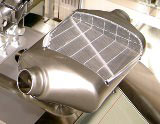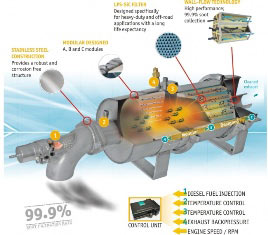DPF - DIESEL PARTICULATE FILTER
- Are you having problems with your DPF?
- Are you facing expensive repair costs to replace the DPF?
- Tired of poor MPG when the DPF is regenerating?
- Want to remove the DPF from your vehicle?
Monster Tuning have decided to invest heavily in the most advanced DPF removal software, thereby improving the quality of the DPF remaps and also offer a wider range of vehicles available to have DPF removal software applied. This is the most sophisticated solution on the market and none of your competitors can offer better.
It is important to understand that the DPF removal process is technically complex and a fast developing are within the industry. Therefore it might not always be 100% right first time and re-work might occasionally be needed.
Our DPF remaps will now alter the software in the ECU (Engine Control Unit) so that in combination with physically removing the DPF, the vehicle will now run without logging any error codes, attempting any future regeneration, or bringing any DPF check lights or engine management light on the dash.
The DPF remap is designed to work with your dealer tools either CMD or KESSv2, whilst programming the vehicle. For those of you who are not aware the DPF does have to be physically removed, jut installing the software will be of absolutely no benefit. In all cases both the pre and post temperature and pressure sensors must still be fitted in the exhaust system, and all fully working, it is only the centre of the DPF filter which is required for removal.
Monster Tuning as a business will not be supplying DPF replacement pipes or specific advice onto how to remove the DPF, our skills and responsibility starts and ends with the software, it is up to you or your trade customer to handle the physical removal of the exhaust components.
Most vehicles fitted with a DPF will need to have the filter replaced at some time, this can be hugely expensive costing anywhere from £1,000 for a cheaper vehicle, right up to £5,000 for some vehicles. The DPF is not a legal requirement, nor is it needed for the MOT test so the most cost effective solution is to remove the DPF from the exhaust system and deactivate the DPF functions from the ECU.
WHAT IS A DPF?
 DPF is an abbreviation for Diesel Particulate Filter and on some French manufacturer vehicles it is also known as a FAP or "filtre à particules". The common symbols on the dashboard are:
DPF is an abbreviation for Diesel Particulate Filter and on some French manufacturer vehicles it is also known as a FAP or "filtre à particules". The common symbols on the dashboard are:
A DPF is equipped to most modern diesel engines to take out particles from the exhaust gases of diesel engines. This is done to meet various emission standards throughout the world. During general driving the filter fills up and once it reaches a certain level a 30% - 40% the ECU will at will cause the engine to run with a higher exhaust temperature to burn any collected particles and turn them into soot. This is known as the DPF regeneration cycle. Of course the regeneration causes the waste to be sent through the exhaust out into the atmosphere, making the whole concept questionable. Effectively, over time the DPF holds back particles, so yes the exhaust is cleaner, then it throws out everything at once during regeneration? This is a technical and sophisticated process and we are acknowledged experts, probably removing more DPF's daily than any other company. In every case the filter has to be physically removed from the vehicle. Beware of anyone who might say otherwise who might just modify your ECU with cheap cracked software and run! Your vehicle will soon become un-driveable and the corrective bills could be substantial.
 The particle filter reduces the pollution emitted by diesel vehicles by filtering the solid particles contained in the exhaust gases. As part of the increasingly tight exhaust emission regulations, EURO4 and EURO5 standards, particulate filters are being fitted to more and more new diesel cars to trap these sooty bits.
The particle filter reduces the pollution emitted by diesel vehicles by filtering the solid particles contained in the exhaust gases. As part of the increasingly tight exhaust emission regulations, EURO4 and EURO5 standards, particulate filters are being fitted to more and more new diesel cars to trap these sooty bits.
Two types of particulate filter are in used - those with additive and those without. To enable a vehicle to use a system without additive the particulate filter must be fitted close to the engine. Because the exhaust gases will not have travelled far from the engine they will still be hot enough to burn off the carbon soot particles. In these systems an oxidising catalytic converter will be integrated into the particulate filter. In other systems the particulate filter is fitted some distance from the engine and as the exhaust gases travel along the exhaust they cool. The temperatures required for ignition of the exhaust gas can only be achieved by the use of an additive.
THE ADDITIVE
The additive is stored in a separate tank. It is difficult to establish it’s precise chemical composition, but it is described as an iron-rich substance dissolved in a hydrocarbon mixture. It works by allowing the carbon particles trapped in the particulate filter to burn at a significantly lower temperature than would usually be required (500ºC rather than 600 - 650ºC). This means that the particulate filter can be regenerated at part throttle.
The additive automatically mixes with the fuel at every fuel tank fill up. The fuel tank sender sends information to the engine ECU about how much fuel has been added. The engine ECU then actuates the particulate filter additive pump. Additive is supplied to the main fuel tank so that the concentration of iron molecules in the fuel is 10 parts per million. In practical terms this means you need 1 litre of additive to 2800 litres (about 620 gallons).
REGENERATION
 In time, the particle filter becomes clogged by accumulation of the following components:
In time, the particle filter becomes clogged by accumulation of the following components:
- Soot coming from the exhaust
- Cinders arising from the engine oil
- Particles coming from engine wear
When the filter becomes clogged a regeneration or burn off is needed. The engine management ECU initiates the whole regeneration process – it receives information from the exhaust gas pressure sensor (a full particulate filter gives a high resistance to gas flow), the air mass meter and the temperature sender which is fitted just before the particulate filter.
Regeneration is usually necessary after between 300 and 450 miles, depending on how the vehicle is driven. The process takes about 5 – 10 minutes and the driver shouldn’t notice it is occurring, although sometimes there may be a puff of white smoke from the exhaust during regeneration. There are two types of regeneration – passive and active. Passive regeneration takes place, automatically, on motorway-type runs in which the exhaust temperature is high (somewhere between 350ºC and 500ºC). As the exhaust is so hot (hot enough to ignite the soot particles) the regeneration process can carry on continuously and steadily across the platinum coated catalytic converter. when engine operating conditions are correct, and by injecting an additional post injection fuel spray, during the combustion process, during valve overlap, the temperature of the exhaust gases increases aiding the burn off. During regeneration the soot is converted to a very small volume of ash which remains in the filter.
As from the factory, occasionally the filter cannot regenerate on its own and a forced active regeneration is required via a dealer level diagnostic tool. If a filter is to heavily loaded a replacement filter must be fitted if not temperatures can get very high and could cause a fire.
It is very important to understand that even with the advanced systems we’ll be using that the DPF software is not a 100% exact science, as new software versions and calibrations are constantly being introduced. In the event that the software does not successfully turn off the DPF calibration in the ECU strategy, our procedure is then to send the vehicles original file to our DPF software designers who will generate a bespoke solution. Whilst this is positive from the point of view that a solution can almost certainly be found, please bear in mind that you may have to return to the vehicle at a later date with a solution.
HOW DPF WORKS?
The DPF will capture 90 percent or better of all harmful diesel emissions. Once the DPF has filled up with soot, it requires having a regeneration cycle in order to burn all the soot out. During this process is that the engine's computer has decided from the information that it receives from the sensors installed in the exhaust that the DPF has become “full” past it’s acceptable limit. The computer then opens the EGR (Exhaust Recirculation Valve) introducing hot exhaust into the intake to help to get exhaust gas temps higher and also injects a small shot of fuel into the cylinders when the exhaust valves are open. The raised exhaust temps and the small amount of fuel then burn out the particulate (soot) that the DPF has collected since it's last regeneration. Then once the computer gets readings from the sensors in the exhaust that the filter is flowing an acceptable limit again, it ends the regeneration cycle. The frequency of this cleaning cycle is different from vehicle to vehicle depending on use, mileage, and engine condition.
BENEFITS OF DPF REMOVAL
- Improved MPG – when the DPF file filter is removed, the car breathes easier and fuel is not wasted on regeneration
- Improved Performance –you may have noticed a decrease in performance, gradually over time? Without the restriction in the exhaust system of a blocked DPF, the car will perform much better again.
- No more limp modes - The ECU can cause the engine to go into Limp Mode to limit potential damage if there is a DPF regeneration failure, which would have meant another expensive garage visit
- No expensive DPF replacements
When combined with a remap at the same the performance and economy improvements to the vehicle can be quite astounding
IS DPF REMOVAL LEGAL?
At present it is not illegal to remove the DPF and it doesn’t form part of the MOT test. Whether this might be tightened up in the future, no one knows and our best guess that even if it is, then it will not be applied retrospectively.
There is a small part of the MOT regulations that say there should not be physical change to the emissions system, however the removal of the DPF will not change the results of the diesel smoke test and at present no other emissions related test is done during the diesel MOT.
As mentioned earlier, we will only supply the software modification to allow the engine management system to cope with the removal of the DPF, whether you physically offer a removal service is entirely separate to your Quantum dealership and it your responsibility to ensure that your customer is adequately informed of the up-to-date position regarding legality.
DPF BUSINESS OPPORTUNITY
 DPF removal is becoming hot news and it’s a great opportunity to increase your business, both on direct customer sales, as well as supplying the local trade and this area should not be ignored. You can be virtually guaranteed that every garage has had to deal with a DPF problem, which often involves them taking the flak for something outside their control, so in most cases your offering will be most welcome.
DPF removal is becoming hot news and it’s a great opportunity to increase your business, both on direct customer sales, as well as supplying the local trade and this area should not be ignored. You can be virtually guaranteed that every garage has had to deal with a DPF problem, which often involves them taking the flak for something outside their control, so in most cases your offering will be most welcome.
You can offer a software modification for DPF removal, or DPF removal and remap and the cost to you either way is just one file. The solution for the local trade is very cost effective and allows them to turn a £1 to 2,000 plus nightmare for their customer into a £400+ solution and everyone earns out of it and there is a very happy customer at the end of it. Of course the DPF solution is also a foot in the door for normal remaps with a reluctant trade garage.
Contact Details
HalstockYeovil
Somerset
BA22 9SY 01935 891616 07920 523676 sales@geraldhallettlandrover.com


 LAND ROVER
LAND ROVER MITSUBISHI
MITSUBISHI NISSAN
NISSAN